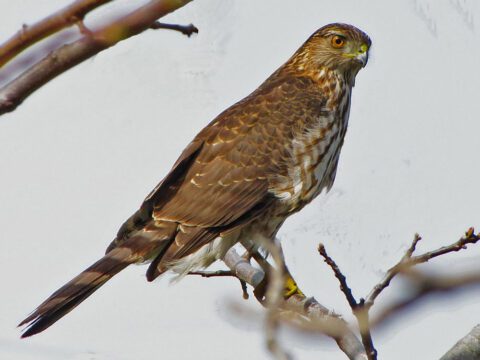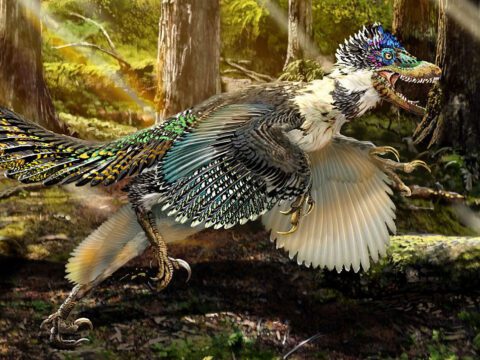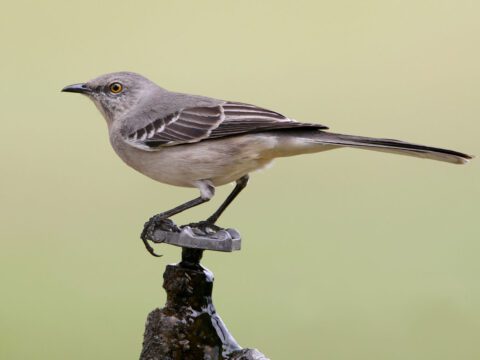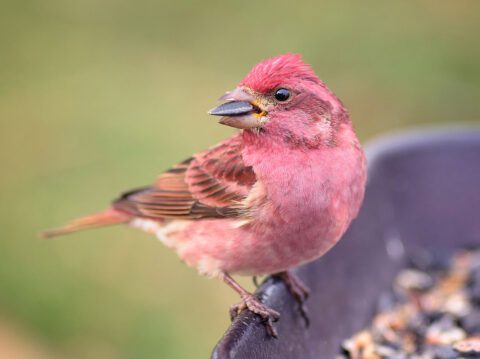Sensing Nature’s Beauty in Sound, Scent, and Touch
By Donna Posont, Michigan teacher April 19, 2012
The spring 2012 issue of BirdScope recaps the Great Backyard Bird Count and takes a look at one particularly skilled set of participants. The “Michigan Bird Brains” are a youth birding team organized by teacher Donna Posont. All of the members, including Donna, are blind, yet the woods are just as full to them as they are to any of us—as Donna shows us in this lyrical essay about a summer walk along the trails of Camp Tuhsmeheta in western Michigan (click the links to hear a Macaulay Library recording of each sound):
Trees are our guideposts in the woods. Walking along the trail, tapping tree roots with our canes, we stop and feel where a Pileated Woodpecker pounded into a tree trunk looking for insects. On another tree trunk, inquisitive fingertips tell us an insect planned to reproduce by using it as a hatchery. The tree fought back by growing a protective gall around the area and radically changed those plans. That whisper-soft thump is an acorn let loose by an oak. The feel of peeling, paper-like bark lets us know we are standing beside a white birch. If one of my companions picks up a leaf, its toothy edges reveal it comes from an American elm. The balsam firs guide us to a nearby picnic pavilion.
Moving down to the lake it’s wonderful to breathe deep and take in the scent of the wild columbine blooming in June. Behind the thick undergrowth a catbird is claiming his territory. Up over the wooded hill there is an ever present chorus of Eastern Wood-Pewees, Blue Jays, Red-eyed Vireos, American Robins, and the always-delightful Black-capped Chickadees. The occasional Ovenbird is calling for the “teacher-teacher-teacher.” In the middle of it all we hear the “yanking” of the White-breasted Nuthatch, walking upside-down to find his meal. We heard a Barred Owl here recently during one of our jaunts. He didn’t stay in one spot for long, probably busy hunting for a mouse. The kids love this bird’s questioning call: Who, who cooks for you, who cooks for you now?
Along the sandy beach there is a new chorus performing for our auditory delight. To the left, in the tallest oak tree, a Red-winged Blackbird utters his oak-a-ree greeting. He isn’t really being friendly, only trying to draw attention away from his multiple mates nesting in the cattails. On the other side of a bridge a pair of Baltimore Orioles is singing, claiming this neck of the woods for nesting. The melody of the male oriole is answered by a chattering female flying over the lake. She may be carrying a twig or grass in her beak to line her nest. Around Flanagan Lake, the chorus includes Song Sparrows, Northern Cardinals, Common Yellowthroats, and the peter-peter-peter call of a Tufted Titmouse. If we manage to get there early enough, we might hear a gagging sound that can only be the Great Blue Heron patrolling for his morning breakfast of fish. A green frog utters his strumming banjo sound to accompany the lakeside singers. Sometimes my fellow hikers feel the imprint of a hoof in the mud where a deer ventured to the edge of the lake for a cool drink.
Next we wander to the camp’s Botting Garden where blueberries, raspberries, and strawberries grow. The raised herb bed is home to aromatic basil, lemon thyme, English thyme, sage, chives, tarragon, chamomile, and cilantro. Cherry tomatoes grow among the herbs too. The fragrant scent of lavender leads us to the perennial bed, where we find more columbine and some dainty foxglove. Interspersed among the vegetable and fruit beds are marigolds and nasturtiums, nature’s own insect repellents.
Without sight, our other senses are fine-tuned to nature’s rhythms and we find ourselves in harmony as she reveals herself to us through touch, sound, and scent.

All About Birds
is a free resource
Available for everyone,
funded by donors like you
American Kestrel by Blair Dudeck / Macaulay Library




